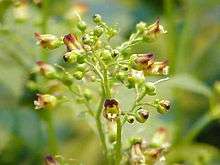Scrophulariaceae
| Figwort family | |
|---|---|
 | |
| Scrophularia nodosa | |
| Scientific classification | |
| Kingdom: | Plantae |
| (unranked): | Angiosperms |
| (unranked): | Eudicots |
| (unranked): | Asterids |
| Order: | Lamiales |
| Family: | Scrophulariaceae Juss. |
| Genera | |
|
See text. | |
| Synonyms | |
|
Bontiaceae Horan. | |
The Scrophulariaceae is a family of flowering plants, commonly known as the figwort family. The plants are annual and perennial herbs, as well as one genus of shrubs. Flowers have bilateral (zygomorphic) or rarely radial (actinomorphic) symmetry. Members of the Scrophulariaceae have a cosmopolitan distribution, with the majority found in temperate areas, including tropical mountains. The family name is based on the name of the included genus Scrophularia L..
Taxonomy
In the past, it was treated as including about 275 genera and over 5,000 species, but its circumscription has been radically altered since numerous molecular phylogenies have shown the traditional broad circumscription to be grossly polyphyletic.[2] Many genera have recently been transferred to other families within the Lamiales, notably Plantaginaceae and Orobanchaceae, but also several new families.[3][4] Several families of the Lamiales have had their circumscriptions enlarged to accommodate genera transferred from the Scrophulariacae sensu lato.
Fischer (2004) considered the family to consist of three subfamilies - Antirrhinoideae, Gratioloideae, and Digitalidoideae. He further divided the Gratioloideae into five tribes - Gratioleae, Angeloniaeae, Stemodieae, Limoselleae, and Lindernieae. He then divided the Gratioleae, with its 16 genera (and about 182 species) into three subtribes - Caprarinae, Dopatrinae, and Gratiolinae. The Gratiolinae had 10 genera (about 121 species) distributed through temperate and tropical America - Bacopa and Mecardonia (formerly Herpestis), Amphianthus, Gratiola, Sophronanthe, Benjaminia, Scoparia, Boelkea, Maeviella, and Braunblequetia. Many of these were transferred to the family Plantaginaceae, in the tribe Gratioleae.
Uses
The family includes some medicinal plants, among them:
- Leptandra, black root, Culver's root
- Scrophularia, figworts
- Verbascum, mulleins
Genera
The Scrophulariaceae family in its APG IV (2016)[5] circumscription includes 62 genera and about 1830 known species.[6]
|
|
Excluded genera
The following genera, traditionally included in the Scrophulariaceae, have been transferred to other families as indicated:
|
|
|
References
- ↑ "Family: Scrophulariaceae Juss., nom. cons.". Germplasm Resources Information Network. United States Department of Agriculture. 2003-01-17. Retrieved 2011-10-17.
- ↑ Fischer says that, if we consider morphology, it has been obvious for the last decades that the Scrophulariaceae do not represent a monophyletic group. See FISCHER (2004), p. 346.
- 1 2 Olmstead, R. G., dePamphilis, C. W., Wolfe, A. D., Young, N. D., Elisons, W. J. & Reeves P. A. (2001). "Disintegration of the Scrophulariaceae". American Journal of Botany. 88 (2): 348–361. doi:10.2307/2657024. JSTOR 2657024. PMID 11222255.
- ↑ Olmstead, R. G. (2003). "Whatever happened to the Scrophulariaceae?". Fremontia. 30: 13–22. - on line here
- ↑ Angiosperm Phylogeny Group (2016), "An update of the Angiosperm Phylogeny Group classification for the orders and families of flowering plants: APG IV", Botanical Journal of the Linnean Society, 161 (2): 105–20, doi:10.1111/boj.12385, retrieved 2016-05-20
- ↑ Christenhusz, M. J. M., and Byng, J. W. (2016). "The number of known plants species in the world and its annual increase". Phytotaxa. Magnolia Press. 261 (3): 201–217. doi:10.11646/phytotaxa.261.3.1.
- ↑ "Genera of Scrophulariaceae tribe Aptosimeae". Germplasm Resources Information Network. United States Department of Agriculture. Retrieved 2015-11-28.
- ↑ "Genera of Scrophulariaceae tribe Buddlejeae". Germplasm Resources Information Network. United States Department of Agriculture. Retrieved 2015-11-28.
- ↑ "Genera of Scrophulariaceae tribe Hemimerideae". Germplasm Resources Information Network. United States Department of Agriculture. Retrieved 2015-11-28.
- ↑ "Genera of Scrophulariaceae tribe Leucophylleae". Germplasm Resources Information Network. United States Department of Agriculture. Retrieved 2015-11-28.
- ↑ Gándara, Etelvina; Victoria Sosa (March 2013). "Testing the monophyly and position of the North American shrubby desert genus Leucophyllum (Scrophulariaceae: Leucophylleae)". Botanical Journal of the Linnean Society. 171 (3): 508–518. doi:10.1111/j.1095-8339.2012.01327.x.
- ↑ "Genera of Scrophulariaceae tribe Limoselleae". Germplasm Resources Information Network. United States Department of Agriculture. Retrieved 2015-11-28.
- 1 2 Kornhall, Per & Bremer, Birgitta (2004). "New circumscription of the tribe Limoselleae (Scrophulariaceae) that includes the taxa of the tribe Manuleeae". Botanical Journal of the Linnean Society. 146 (4): 453–467. doi:10.1111/j.1095-8339.2004.00341.x.
- ↑ Oxelman, B.; Kornhall, P.; Olmstead, R.G.; Bremer, B. (2005). "Further disintegration of the Scrophulariaceae". Taxon. 54 (2): 411–425. doi:10.2307/25065369. JSTOR 25065369.
- ↑ "Genera of Scrophulariaceae tribe Myoporeae". Germplasm Resources Information Network. United States Department of Agriculture. Retrieved 2015-11-28.
- ↑ "Genera of Scrophulariaceae tribe Scrophularieae". Germplasm Resources Information Network. United States Department of Agriculture. Retrieved 2015-11-28.
- ↑ "Genera of Scrophulariaceae tribe Scrophularieae". Germplasm Resources Information Network. United States Department of Agriculture. Retrieved 2015-11-28.
- ↑ "Genera of Scrophulariaceae". Germplasm Resources Information Network. United States Department of Agriculture. Retrieved 2015-11-28.
- ↑ Albach, D. C.; Meudt, H. M.; Oxelman, B. (2005). "Piecing together the "new" Plantaginaceae". American Journal of Botany. 92 (2): 297–315. doi:10.3732/ajb.92.2.297. PMID 21652407.
- ↑ "Lindernia All.". A Catalogue of the Vascular Plants of Madagascar. Missouri Botanical Garden and Muséum National d'Histoire Naturelle.
- ↑ Haston, E., Richardson, J. E., Stevens, P. F., Chase, M. W., Harris, D. J. (2007). "A linear sequence of Angiosperm Phylogeny Group II families". Taxon. 56 (1): 7–12. doi:10.2307/25065731.
- ↑ Nelson D. Young; Kim E. Steiner; Claude W. dePamphilis (Autumn 1999). "The Evolution of Parasitism in Scrophulariaceae/Orobanchaceae: Plastid Gene Sequences Refute an Evolutionary Transition Series". Annals of the Missouri Botanical Garden. 86 (4): 876–893. doi:10.2307/2666173. JSTOR 2666173.
- ↑ "GRIN genera sometimes placed in Scrophulariaceae". Germplasm Resources Information Network. United States Department of Agriculture. Retrieved 2011-10-17.
Bibliography
- Fischer, E. (2004). "Scrophulariaceae". In Kubitzki, K.; Kadereit, J.W. Flowering Plants — Dicotyledons: Lamiales. The Families and Genera of Vascular Plants. VII. Springer. pp. 333−432. ISBN 3-540-40593-3.
External links
| Wikimedia Commons has media related to Scrophulariaceae. |
| Wikispecies has information related to: Scrophulariaceae |
- Kew list of Scrophulariaceae
- Family Scrophulariaceae Flowers in Israel
- verbascum.org
_W2_IMG_1125.jpg)
